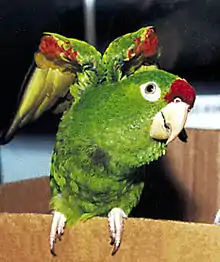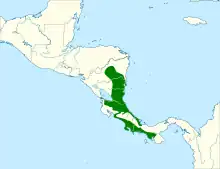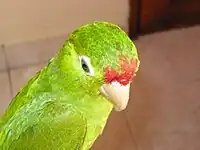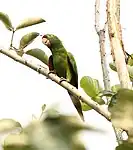Finsch's parakeet
Finsch's parakeet (Psittacara finschi), also known as the crimson-fronted parakeet and in aviculture as Finsch's conure[3], is a species of bird in subfamily Arinae of the family Psittacidae, the African and New World parrots. It is found in Costa Rica, Nicaragua, and Panama.[4]
| Finsch's parakeet | |
|---|---|
 | |
| Scientific classification | |
| Domain: | Eukaryota |
| Kingdom: | Animalia |
| Phylum: | Chordata |
| Clade: | Dinosauria |
| Class: | Aves |
| Order: | Psittaciformes |
| Family: | Psittacidae |
| Genus: | Psittacara |
| Species: | P. finschi |
| Binomial name | |
| Psittacara finschi (Salvin, 1871) | |
 | |
| Synonyms | |
|
Conurus finschi, Salvin, 1871 Aratinga finschi, Salvin, 1871 Aratinga leucophthalma finshi, Salvin, 1871 | |
Taxonomy and systematics
Finsch's parakeet was for a time placed in the genus Aratinga but from about 2013 has been in its present genus Psittacara.[5][6] It was for a time treated as a subspecies of the white-eyed parakeet (P. leucophthalmus), and they constitute a superspecies.[7][6] It is monotypic.[4]
Description
Finsch's parakeet is about 28 cm (11 in) long and weighs 135 to 175 g (4.8 to 6.2 oz). The sexes are alike. Adults are mostly green that is yellowish on their underparts. They have a red forehead (the "front" of their alternate English name) and some red flecks elsewhere on their head. The edge of their wing and their outer underwing coverts are also red, often with an orange tinge. Their greater underwing coverts are yellow. The undersides of their flight feathers and tail are olive yellow. Their thighs usually have some red. Their eye is orange surrounded by bare white skin and their bill is horn colored. Juveniles resemble adults, but have little or no red on the head and none on the thighs. Their eyes are gray.[7][3]
Distribution and habitat
Finsch's parakeet is found from southeastern Nicaragua, on both the Pacific and Caribbean slopes of Costa Rica, and into Panama's Pacific slope as far east as the Azuero Peninsula. It inhabits a variety of semi-open to open landscapes including woodlands, the edges of denser forest, secondary forest, ranchlands and agricultural areas that have groves of trees, coffee plantations, and towns. In elevation it ranges from sea level to 1,800 m (5,900 ft).[7][8]
Behavior
Finsch's parakeet is rather social, often gathering in flocks of about 30 individuals, and several hundred may roost together.[3]
Movement
Finsch's parakeet wanders widely, making irregular and seasonal movements that are not well defined. In the dry season, increased numbers are present on the Pacific side of Costa Rica.[7]
Feeding
Finsch's parakeet feeds on fruits and flowers of a variety of plants and trees. It also feeds on maize and sorghum.[7] It has been observed feeding on wood, an uncommon habit in parrots.[9]
Breeding
Finsch's parakeet nests in Costa Rica during the dry and early wet seasons of December to May, and is thought to nest in July in Panama. It nests in tree cavities which it sometimes excavates itself in rotten wood. It sometimes nests semi-colonially. The clutch is usually 3 to 4 eggs. The incubation period, time to fledging, and details of parental care are not known.[7][3]
Status
The IUCN has assessed Finsch's parakeet as being of Least Concern. It has a large range and its estimated population of at least a half million mature individuals is believed to be stable. No immediate threats have been identified.[1] It is considered abundant in Nicaragua, common in Costa Rica, and locally common in Panama. Its range appears to be increasing as deforestation provides the more open landscapes it prefers. It has not been subject to much cage bird trafficking.[7]
Gallery
 Pair in the wild on the Osa Peninsula, Costa Rica
Pair in the wild on the Osa Peninsula, Costa Rica Juvenile
Juvenile Adult in San José, Costa Rica
Adult in San José, Costa Rica
References
- BirdLife International (2021). "Crimson-fronted Parakeet Psittacara finschi". IUCN Red List of Threatened Species. 2021: e.T22685678A140714894. doi:10.2305/IUCN.UK.2021-3.RLTS.T22685678A140714894.en. Retrieved 8 April 2023.
- "Appendices | CITES". cites.org. Retrieved 8 April 2023.
- "FINSCH'S CONURE (Psittacara finschi)". World Parrot Trust. Retrieved April 8, 2023.
- Gill, F.; Donsker, D.; Rasmussen, P., eds. (January 2023). "Parrots, cockatoos". IOC World Bird List. v 13.1. Retrieved February 18, 2023.
- Remsen, James V.; Urantówka, Adam (2013). "Divide Aratinga into four genera". AOS South American Classification Committee. Retrieved April 5, 2023.
- Chesser, R. T., S. M. Billerman, K. J. Burns, C. Cicero, J. L. Dunn, B. E. Hernández-Baños, R. A. Jiménez, A. W. Kratter, N. A. Mason, P. C. Rasmussen, J. V. Remsen, Jr., D. F. Stotz, and K. Winker. 2022. Check-list of North American Birds (online). American Ornithological Society. https://checklist.aou.org/taxa
- Collar, N., P. F. D. Boesman, and C. J. Sharpe (2020). Crimson-fronted Parakeet (Psittacara finschi), version 1.0. In Birds of the World (J. del Hoyo, A. Elliott, J. Sargatal, D. A. Christie, and E. de Juana, Editors). Cornell Lab of Ornithology, Ithaca, NY, USA. https://doi.org/10.2173/bow.crfpar.01 retrieved April 8, 2023
- Garrigues, Richard; Dean, Robert (2007). The Birds of Costa Rica. Ithaca: Zona Tropical/Comstock/Cornell University Press. p. 94. ISBN 978-0-8014-7373-9.
- Ramírez-Fernández, José D.; et al. (2019). "PREVIOSULY UNDESCRIBED FOOD RESOURCES OF ELEVEN NEOTROPICAL BIRD SPECIES" (PDF). Boletín SAO. 28 (1 & 2): 1–8. Retrieved April 8, 2023.
